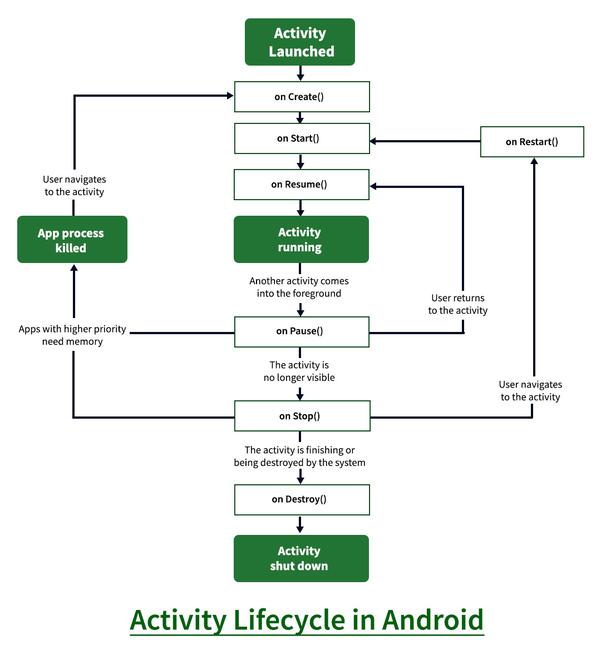Table of Contents
In Android, an activity is referred to as one screen in an application. It is very similar to a single window of any desktop application. An Android app consists of one or more screens or activities.
Each activity goes through various stages or a lifecycle and is managed by activity stacks. So when a new activity starts, the previous one always remains below it. There are four stages of an activity life cycle in android.
- If an activity is in the foreground of the screen i.e at the top of the stack, then it is said to be active or running. This is usually the activity that the user is currently interacting with.
- If an activity has lost focus and a non-full-sized or transparent activity has focused on top of your activity. In such a case either another activity has a higher position in multi-window mode or the activity itself is not focusable in the current window mode. Such activity is completely alive.
- If an activity is completely hidden by another activity, it is stopped or hidden. It still retains all the information, and as its window is hidden thus it will often be killed by the system when memory is needed elsewhere.
- The system can destroy the activity from memory by either asking it to finish or simply killing its process. When it is displayed again to the user, it must be completely restarted and restored to its previous state.
Entri gives you the best Coding experience
For each stage, android provides us with a set of 7 methods that have their own significance for each stage in the life cycle. The image shows a path of migration whenever an app switches from one state to another.
Detailed introduction on each of the method is stated as follows:
1. onCreate()
It is called when the activity is first created. This is where all the static work is done like creating views, binding data to lists, etc. This method also provides a Bundle containing its previous frozen state, if there was one.
Example:
- Java
- Kotlin
import android.support.v7.app.AppCompatActivity;import android.os.Bundle;import android.widget.Toast;public class MainActivity extends AppCompatActivity { @Override protected void onCreate(Bundle savedInstanceState) { super.onCreate(savedInstanceState); // Bundle containing previous frozen state setContentView(R.layout.activity_main); // The content view pointing to the id of layout // in the file activity_main.xml Toast toast = Toast.makeText(getApplicationContext(), "onCreate Called", Toast.LENGTH_LONG).show(); }} |
Entri gives you the best Coding experience
2. onStart()
It is invoked when the activity is visible to the user. It is followed by onResume() if the activity is invoked from the background. It is also invoked after onCreate() when the activity is first started.
Example:
- Java
- Kotlin
import android.support.v7.app.AppCompatActivity;import android.os.Bundle;import android.widget.Toast;public class MainActivity extends AppCompatActivity { @Override protected void onCreate(Bundle savedInstanceState) { super.onCreate(savedInstanceState); // Bundle containing previous frozen state setContentView(R.layout.activity_main); // The content view pointing to the id of layout // in the file activity_main.xml Toast toast = Toast.makeText(getApplicationContext(), "onCreate Called", Toast.LENGTH_LONG).show(); } protected void onStart() { // It will show a message on the screen // then onStart is invoked Toast toast = Toast.makeText(getApplicationContext(), "onStart Called", Toast.LENGTH_LONG).show(); }} |
Entri gives you the best Coding experience
3. onRestart()
It is invoked after the activity has been stopped and prior to its starting stage and thus is always followed by onStart() when any activity is revived from background to on-screen.
Example:
- Java
- Kotlin
import android.support.v7.app.AppCompatActivity;import android.os.Bundle;import android.widget.Toast;public class MainActivity extends AppCompatActivity { @Override protected void onCreate(Bundle savedInstanceState) { super.onCreate(savedInstanceState); // Bundle containing previous frozen state setContentView(R.layout.activity_main); // The content view pointing to the id of layout // in the file activity_main.xml Toast toast = Toast.makeText(getApplicationContext(), "onCreate Called", Toast.LENGTH_LONG).show(); } protected void onRestart() { // It will show a message on the screen // then onRestart is invoked Toast toast = Toast.makeText(getApplicationContext(), "onRestart Called", Toast.LENGTH_LONG).show(); }} |
Entri gives you the best Coding experience
4. onResume()
It is invoked when the activity starts interacting with the user. At this point, the activity is at the top of the activity stack, with a user interacting with it. Always followed by onPause() when the activity goes into the background or is closed by the user.
Example:
- Java
- Kotlin
import android.support.v7.app.AppCompatActivity;import android.os.Bundle;import android.widget.Toast;import com.example.share.R;public class MainActivity extends AppCompatActivity { @Override protected void onCreate(Bundle savedInstanceState) { // Bundle containing previous frozen state super.onCreate(savedInstanceState); // The content view pointing to the id of layout // in the file activity_main.xml setContentView(R.layout.activity_main); Toast toast = Toast.makeText(getApplicationContext(), "onCreate Called", Toast.LENGTH_LONG).show(); } protected void onResume() { // It will show a message on the screen // then onResume is invoked Toast toast = Toast.makeText(getApplicationContext(), "onResume Called", Toast.LENGTH_LONG).show(); }} |
Entri gives you the best Coding experience
5. onPause()
It is invoked when an activity is going into the background but has not yet been killed. It is a counterpart to onResume(). When an activity is launched in front of another activity, this callback will be invoked on the top activity (currently on screen). The activity, under the active activity, will not be created until the active activity’s onPause() returns, so it is recommended that heavy processing should not be done in this part.
Example:
- Java
- Kotlin
import android.support.v7.app.AppCompatActivity;import android.os.Bundle;import android.widget.Toast;public class MainActivity extends AppCompatActivity { @Override protected void onCreate(Bundle savedInstanceState) { // Bundle containing previous frozen state super.onCreate(savedInstanceState); // The content view pointing to the id of layout // in the file activity_main.xml setContentView(R.layout.activity_main); Toast toast = Toast.makeText(getApplicationContext(), "onCreate Called", Toast.LENGTH_LONG).show(); } protected void onPause() { // It will show a message on the screen // then onPause is invoked Toast toast = Toast.makeText(getApplicationContext(), "onPause Called", Toast.LENGTH_LONG).show(); }} |
Entri gives you the best Coding experience
6. onStop()
It is invoked when the activity is not visible to the user. It is followed by onRestart() when the activity is revoked from the background, followed by onDestroy() when the activity is closed or finished, and nothing when the activity remains on the background only. Note that this method may never be called, in low memory situations where the system does not have enough memory to keep the activity’s process running after its onPause() method is called.
Example:
- Java
- Kotlin
import android.support.v7.app.AppCompatActivity;import android.os.Bundle;import android.widget.Toast;public class MainActivity extends AppCompatActivity { @Override protected void onCreate(Bundle savedInstanceState) { // Bundle containing previous frozen state super.onCreate(savedInstanceState); // The content view pointing to the id of layout // in the file activity_main.xml setContentView(R.layout.activity_main); Toast toast = Toast.makeText(getApplicationContext(), "onCreate Called", Toast.LENGTH_LONG).show(); } protected void onStop() { // It will show a message on the screen // then onStop is invoked Toast toast = Toast.makeText(getApplicationContext(), "onStop Called", Toast.LENGTH_LONG).show(); }} |
Entri gives you the best Coding experience
7. onDestroy()
The final call received before the activity is destroyed. This can happen either because the activity is finishing (when finish() is invoked) or because the system is temporarily destroying this instance of the activity to save space. To distinguish between these scenarios, check it with isFinishing() method.
Example:
- Java
- Kotlin
import android.support.v7.app.AppCompatActivity;import android.os.Bundle;import android.widget.Toast;public class MainActivity extends AppCompatActivity { @Override protected void onCreate(Bundle savedInstanceState) { // Bundle containing previous frozen state super.onCreate(savedInstanceState); // The content view pointing to the id of layout // in the file activity_main.xml setContentView(R.layout.activity_main); Toast toast = Toast.makeText(getApplicationContext(), "onCreate Called", Toast.LENGTH_LONG).show(); } protected void onDestroy() { // It will show a message on the screen // then onDestroy is invoked Toast toast = Toast.makeText(getApplicationContext(), "onDestroy Called", Toast.LENGTH_LONG).show(); }} |
Entri gives you the best Coding experience
Demo Android App to Demonstrate Activity Lifecycle in Android
- Java
- Kotlin
import android.support.v7.app.AppCompatActivity;import android.os.Bundle;import android.widget.Toast;public class MainActivity extends AppCompatActivity { @Override protected void onCreate(Bundle savedInstanceState) { super.onCreate(savedInstanceState); setContentView(R.layout.activity_main); Toast toast = Toast.makeText(getApplicationContext(), "onCreate Called", Toast.LENGTH_LONG).show(); } protected void onStart() { super.onStart(); Toast toast = Toast.makeText(getApplicationContext(), "onStart Called", Toast.LENGTH_LONG).show(); } @Override protected void onRestart() { super.onRestart(); Toast toast = Toast.makeText(getApplicationContext(), "onRestart Called", Toast.LENGTH_LONG).show(); } protected void onPause() { super.onPause(); Toast toast = Toast.makeText(getApplicationContext(), "onPause Called", Toast.LENGTH_LONG).show(); } protected void onResume() { super.onResume(); Toast toast = Toast.makeText(getApplicationContext(), "onResume Called", Toast.LENGTH_LONG).show(); } protected void onStop() { super.onStop(); Toast toast = Toast.makeText(getApplicationContext(), "onStop Called", Toast.LENGTH_LONG).show(); } protected void onDestroy() { super.onDestroy(); Toast toast = Toast.makeText(getApplicationContext(), "onDestroy Called", Toast.LENGTH_LONG).show(); }} |
Entri gives you the best Coding experience
Conclusion
In this article , we learned about various activity life cycle in android.














